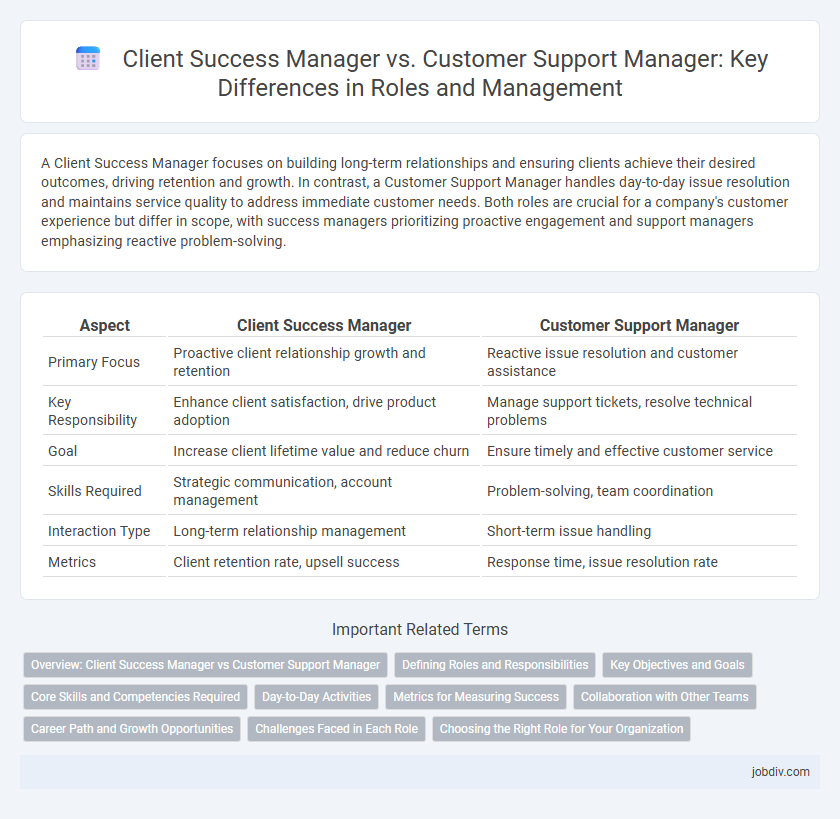A Client Success Manager focuses on building long-term relationships and ensuring clients achieve their desired outcomes, driving retention and growth. In contrast, a Customer Support Manager handles day-to-day issue resolution and maintains service quality to address immediate customer needs. Both roles are crucial for a company's customer experience but differ in scope, with success managers prioritizing proactive engagement and support managers emphasizing reactive problem-solving.
Table of Comparison
| Aspect | Client Success Manager | Customer Support Manager |
|---|---|---|
| Primary Focus | Proactive client relationship growth and retention | Reactive issue resolution and customer assistance |
| Key Responsibility | Enhance client satisfaction, drive product adoption | Manage support tickets, resolve technical problems |
| Goal | Increase client lifetime value and reduce churn | Ensure timely and effective customer service |
| Skills Required | Strategic communication, account management | Problem-solving, team coordination |
| Interaction Type | Long-term relationship management | Short-term issue handling |
| Metrics | Client retention rate, upsell success | Response time, issue resolution rate |
Overview: Client Success Manager vs Customer Support Manager
A Client Success Manager focuses on proactive relationship building and strategic guidance to ensure long-term client satisfaction and retention, often working closely with sales and product teams to maximize business value. In contrast, a Customer Support Manager handles reactive issue resolution and manages support teams to address customer inquiries and problems promptly, emphasizing operational efficiency and service quality. Both roles require strong communication skills but differ in their approach to customer engagement and business objectives.
Defining Roles and Responsibilities
Client Success Managers focus on building long-term relationships by proactively ensuring clients achieve their desired outcomes through tailored solutions and strategic guidance. Customer Support Managers oversee reactive assistance, managing support teams to resolve technical issues and maintain service quality promptly. Defining these roles clearly separates strategic client engagement from operational problem resolution, optimizing overall customer satisfaction and retention.
Key Objectives and Goals
Client Success Managers prioritize proactive relationship-building and long-term value creation by aligning solutions with client goals to drive retention and expansion. Customer Support Managers focus on resolving immediate issues efficiently, maintaining high satisfaction levels through timely troubleshooting and support. Both roles aim to enhance customer satisfaction but differ in strategy: success managers emphasize strategic growth, while support managers target operational excellence.
Core Skills and Competencies Required
Client Success Managers require strong relationship-building abilities, strategic thinking, and an in-depth understanding of client business goals to drive long-term value and retention. Customer Support Managers focus on problem-solving skills, technical knowledge, and the capacity to manage support teams effectively to resolve issues promptly and ensure customer satisfaction. Both roles demand excellent communication skills, empathy, and proficiency in CRM tools to track interactions and measure success outcomes.
Day-to-Day Activities
Client Success Managers focus on proactive engagement, ensuring clients achieve their desired outcomes through strategic planning, regular check-ins, and performance tracking. Customer Support Managers handle reactive issue resolution by overseeing support teams, managing tickets, and ensuring timely response to customer inquiries and complaints. While Client Success Managers prioritize long-term relationship building and growth, Customer Support Managers concentrate on immediate problem-solving and operational efficiency.
Metrics for Measuring Success
Client Success Managers drive long-term value by focusing on metrics like Net Promoter Score (NPS), Customer Lifetime Value (CLV), and churn rate, reflecting customer loyalty and retention. Customer Support Managers prioritize First Response Time, Resolution Time, and Customer Satisfaction Score (CSAT) to measure immediate issue resolution efficiency and customer satisfaction. Both roles require distinct KPIs to align with their strategic goals in managing customer relationships effectively.
Collaboration with Other Teams
Client Success Managers collaborate closely with Sales, Product Development, and Marketing teams to ensure client needs are anticipated and solutions are customized for long-term retention. Customer Support Managers primarily work with Technical Support and Quality Assurance departments to resolve immediate issues and improve service efficiency. Both roles require effective interdepartmental communication, but Client Success Managers focus more on proactive strategy alignment while Customer Support Managers emphasize reactive problem-solving coordination.
Career Path and Growth Opportunities
Client Success Managers typically advance through strategic roles such as Customer Experience Director or VP of Client Success, emphasizing proactive relationship management and business growth. Customer Support Managers often progress toward operations-focused positions like Support Operations Manager or Head of Customer Service, prioritizing issue resolution and team management. Career growth for Client Success Managers centers on client retention and revenue impact, whereas Customer Support Managers focus on process optimization and customer satisfaction metrics.
Challenges Faced in Each Role
Client Success Managers often struggle with proactively aligning clients' evolving goals to company solutions, requiring deep strategic insight and continuous relationship nurturing. Customer Support Managers primarily face high-pressure environments managing real-time issue resolution while maintaining team morale and meeting strict service level agreements. Both roles demand distinct approaches to communication, with Client Success focusing on long-term value creation and Customer Support emphasizing immediate problem-solving efficiency.
Choosing the Right Role for Your Organization
Selecting between a Client Success Manager and a Customer Support Manager depends on organizational goals and customer interaction strategies. A Client Success Manager focuses on long-term relationship building, driving customer retention, and revenue growth through proactive engagement. In contrast, a Customer Support Manager handles immediate issue resolution and operational efficiency, emphasizing reactive problem-solving and support metrics.
Client Success Manager vs Customer Support Manager Infographic

 jobdiv.com
jobdiv.com